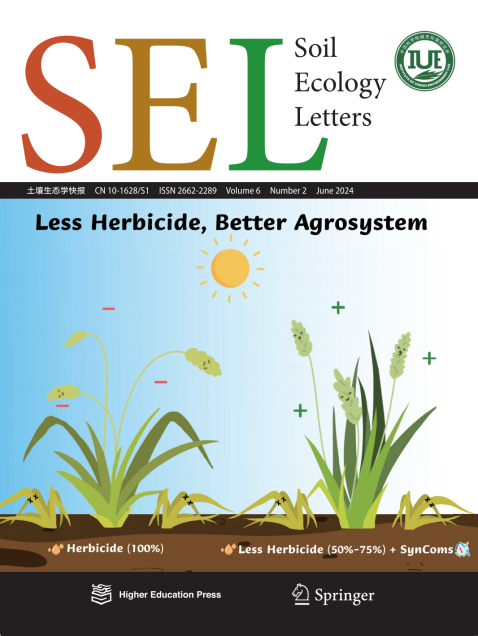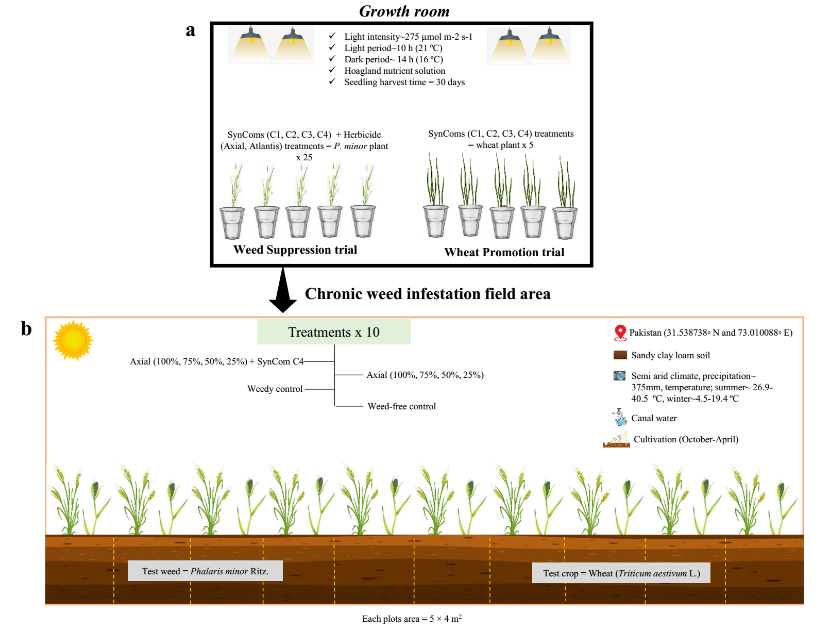南湖新闻网讯(通讯员 吴尘聊)近日,我校农业微生物资源发掘与利用全国重点实验室、资源与环境学院蔡鹏教授团队提出了一种利用合成微生物群落管理田间杂草,从而减少传统除草剂用量的策略,相关研究成果以“Integrated application of synthetic community reduces consumption of herbicide in field Phalaris minor control”为题在Soil Ecology Letters上以Cover Story的形式发表。

《土壤生态学快报》2024年第6期封面展示该项研究成果
田间杂草控制是粮食生产的基本需求,然而低靶向性的化学除草剂的长期大量施用带来了杂草除草抗性的提高和环境的污染,因此如何降低除草剂用量和环境风险已经成为迫切需要探索和解决的环境问题。目前,利用合成微生物群落(SynComs)实现田间作物管理已然成为绿色农业发展的重要研究思路,基于理性设计的微生物组合被认为可以在作物生长中发挥重要调控作用。然而,是否能通过合成群落将植物促生菌(PGPR)的生长调控潜力与除草剂使用相结合,从而提供可持续和环保的杂草控制策略尚待探索。
基于上述背景,该团队先在温室条件下测试了从杂草和小麦根际分离的4个假单胞菌菌株,构建多种合成群落后,以典型杂草小子虉草(Phalaris minor)评估其与不同剂量除草剂联合施用时的除草潜力。他们发现,特定组成的合成群落(C4),与低剂量除草剂联合使用时能对杂草产生高效的抑制。值得注意的是,即使没有除草剂的帮助,该组合也显著促进了小麦的生长。这一发现强调了有益根际细菌的关键作用,它可以通过产生各种代谢产物来降低杂草密度并确保作物产量。
为了检验该合成群落在实际生产中可能的效用,该团队以该组合投入大田实验,在与不同剂量的除草剂进行混合施用后他们发现, C4组合不仅可以有效缓解除草剂对小麦的副作用,改善小麦的生长状况。同时,配合施用该合成群落后即使降低除草剂的投入(50%-75%),依然能显著减少杂草引起的小麦产量损失(8%-22%),效果显著优于单独施用高浓度除草剂。
这些发现突出了除草剂与合成微生物群落结合的协同效应,证明了利用微生物强化除草剂功能同时降低除草剂使用的现实可行性,提出了利用合成菌群实现绿色可持续的环境友好型的杂草控制策略。

研究总体技术路线
华中农业大学资源与环境学院博士生Amina Hadayat为论文第一作者,高春辉副研究员为论文通讯作者。该研究得到了巴基斯坦高等教育委员会技术发展基金项目、国家自然科学基金和中央高校基本科研业务的资助。
审核人:高春辉
摘要:To address environmental concerns and manage resistant weeds, there is a growing demand for eco-friendly alternatives. In this study, we propose the integration of synthetic communities (SynComs) to reduce herbicide consumption. Four SynComs, consisting of bacteria isolated from weed or wheat rhizospheres, were first evaluated under greenhouse conditions. All SynComs enhanced wheat growth, which was manifested by increased Soil Plant Analysis Development (SPAD) values and fresh biomass. At the same time, SynCom C4 effectively reduced SPAD values and fresh biomass of the infesting weed, Phalaris minor, when combined with low-dose Axial herbicide. A field trial was then conducted using the C4 SynCom and various doses of Axial (100%, 75%, 50%, and 25%). Remarkably, the combination of C4 with 50% and 75% Axial significantly improved wheat growth by mitigating the side effects of herbicide on wheat. Weed infestation reduced grain yield by 16% and 25% at the dose of 50% and 75% Axial, respectively. The combination of Axial with C4 rescued up to 22% of grain yield loss under infested weed compared with Axial alone. Our findings suggested that the combination of herbicides with SynComs exhibited synergistic effects for controlling Phalaris minor and promoting wheat growth, so that such combination provides a sustainable and eco-friendly weed control strategy.